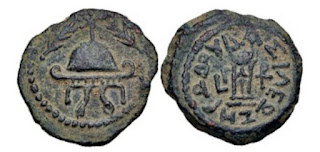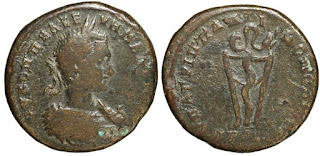The word ''tripod'' meaning three-footed and refers to a three-legged structure, is one of the oldest words in Greek.
Greek coin, 330-300 BC, with ornate tripod
In fact, no other word in that language could be demonstrated to be older, for it appears in the Linear B script, dating to the 13th century BC. The word appears on the clay tablet discovered in Pylos, Greece. The word ti-ri-po-de appears in syllabic characters along with a drawing of a three-legged vessel on the tablet.
A sacrificial tripod was three legged and was used for offerings or other ritual procedures.
Bronze tripod with serpent motifs
It was the universal practice of the Greeks to undertake no matter of importance without first asking the advice of the Gods, and there were many sacred spots where God answered the worshippers. The oracle at Delphi surpassed all the rest in importance and was regarded with great respect in every part of the Grecian world. In the center of the temple of Delphi there was a small opening in the ground from which it is said some vapour ascended. Whenever the oracle was to be consulted, the priestess called Pythia took her seat.
The most famous tripod of ancient Greece was the ''Delphic Tripod'' on which the Pythian priestess took her seat to deliver the oracles of the deity. The seat was formed by a circular slab on the top of the tripod, on which a branch of laurel was deposited when it was unoccupied by the priestess. The tripod was sacred to Apollo. According to the myth, a fight resulted between Apollo and Heracles, after Heracles did not get any answer from the oracle of Delphi, that enraged Heracles who grabbed the tripod on which the Pythia sat in order to pronounce her oracles. Finally, Zeus had to intervene to end the quarrel.
Apollo and Heracles struggle for the Delphic tripod, hydria, 520 BC
The Pythia was the name of the high priestess of the Temple of Apollo at Delphi, also known as the Oracle of Delphi, which may have been present in some form from 1400 BC but was established by Apollo in the 8th century BC and was widely credited for her prophecies uttered under divine possession. During the period from the end of 7th century BC till the 4th century AD, the Delphi Oracle was the most prestigious and authoritative oracle amongst Greeks
Delphic tripod, red figured bell krater, Paestum, 330 BC
Another well-known tripod in Delphi was the Plataean Tripod. It consisted of a golden basin, supported by a bronze serpent with three heads. It was made from the tenth part of the spoils taken from the Persian army after the Battle of Plataea in 479 BC. The golden bowl was carried off by the Phocians during the Third Sacred War (356-346 BC) and the stand was removed by the emperor Constantine in 324 AD and taken to Constantinople (present day Istanbul).
Tripods are mentioned by Homer (one of the greatest and most influential writers of Greek literature, 750 BC) as gifts and prizes during athletics games. They were also used as offerings to the deities.
In ancient China, sacrificial tripods have been part of the culture since the Neolitic cultures of Cishan (6500-5000 BC) and Peiligang in the 7th and 8th millennium BC. They are often referred to as ''dings''
Shang Dynasty, 1600-1046 BC, Ding
Kroton, Bruttium, 530-480 BC, AR Nomos, tripod with stork at right and on reverse incuse tripod
Cassander, Macedonia, 316-297 BC, bronze, head of Apollo facing right with Tripod on reverse.
Judaea, Herod I, 40 BC, Eight Prutot, weight 6.1 g, RY 3 (38/7 BC), Ornate helmet, palms flanking, Tripod, date to left, monogram to right
Kroton, Bruttinum, 420 BC, AR Nomos, Herakles left seated on rock, draped with a lionskin, holding branch in right hand, club in left, an altar before him, bow and bow case behind, two fish in Kroton below tripod, legs terminating in lion's feet, tied with a fillet, to the left, Apollo Pythios taking aim at a coiled python to the right
Seleucid, 261-246 BC, weight 4.4 g, bronze, laureate head of Apollo right, Tripod on reverse
Seleucid, 246 BC, bronze, laureate head of Apollo right, Tripod on reverse
Judaea, Herod I, 40-4 BC, Two Prutot, weight 4,1 g, Jerusalem mint, Cross within closed diadem, Tripod table bearing vessel, palm branch to left and right
Sacrificial Tripod

























No comments:
Post a Comment
Any inputs or feedback is welcome!